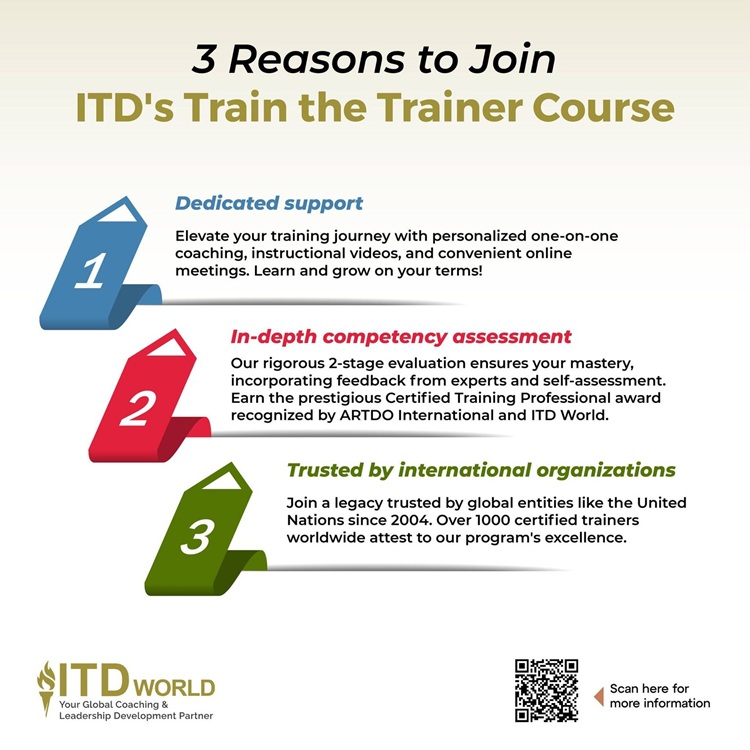These days, the demand for high-quality training is at an all-time high – whether it is in an educational or corporate setting. To meet this demand, more and more are turning to the “Train the Trainer” model as a solution to ensure excellence in training.
|
Author: Jonathan M. Pham |
Highlights
- Core Purpose: Train the Trainer (TTT) is a dynamic framework for cultivating and enhancing internal training capabilities by equipping subject matter experts (SMEs) or potential instructors with the skills, strategies, and confidence needed to effectively impart knowledge to their colleagues and peers.
- Key Organizational Benefits: TTT offers substantial strategic value, including cost-effectiveness (reducing reliance on external trainers), ensuring consistency and quality across training delivery, increasing training capacity for large or rapidly growing workforces, and fostering an organizational learning culture.
- TTT Methodology: The process is systematic, beginning with identifying training needs and selecting the right trainer candidates (based on expertise and communication skills). It progresses through designing the TTT curriculum (covering pedagogy, instructional design, etc.), delivering the training, and concluding with ongoing support and evaluation/feedback.
- Core Training Topics & Activities: TTT programs focus on practical skills like presentation/facilitation skills, training design principles, and classroom management. Activities such as microteaching (participants practice delivering short sessions), role-playing, and simulations are employed to promote active learning and skill development.
- Best Practices for Success: Effective TTT implementation requires tailoring the program to the organization’s specific context, setting clear, measurable objectives, designing highly engaging sessions, and employing a variety of instructional techniques that incorporate adult learning principles to encourage active participation.
What is Train the Trainer?
Train the Trainer (TTT) is a dynamic framework employed by organizations to cultivate and enhance their internal training capabilities – therefore effectively building up a self-sustaining ecosystem of skill and knowledge transfer. At its core, the goal is to groom potential instructors/ subject matter experts (SMEs) and equip them with the skills, strategies, and confidence needed to impart knowledge to their colleagues/ peers.
In essence, TTT isn’t just about transmitting specific training content; it’s about creating a new generation of capable trainers who can effectively convey this content to others.
Below are a few examples of how Train the Trainer (TTT) model may be applied in various industries:
- Sales training: A company that sells software to businesses might use a TTT program to train its sales team on the new features of its product. The sales team would then be able to instruct their customers on how to use the software.
- Customer service training: At a retail company, the customer service representatives are trained on how to handle complaints – so that they would then be able to mentor their colleagues on the topic.
- Leadership Training: A company decides to organize a TTT program revolving around effective leadership. The managers would then be able to help their employees become more successful in their roles.
This approach serves as a valuable and cost-effective strategy, allowing organizations to establish a consistent mechanism for knowledge dissemination, nurturing a skilled workforce, and securing their talent pipeline for future leadership positions. TTT doesn’t limit itself to specific domains; it’s a versatile methodology that can be applied to any area of knowledge or skills within any professional setting.
History of Train the Trainer Model
Back in the early 1900s, organizations started to recognize the significance of training their employees to enhance productivity and efficiency. At that time, the traditional one-on-one apprenticeship model, while effective, was insufficient for meeting the growing demands of a rapidly expanding workforce.
To address this challenge, businesses began developing Train the Trainer (TTT) programs – which marked a significant departure from the conventional approach, as they focused on equipping select individuals with the knowledge and skills necessary to effectively train others. The content of such programs encompassed various crucial areas, including adult learning principles, training design and development, presentation skills, and methods for evaluating training effectiveness.
The Train the Trainer model gained popularity during the World War II era. The U.S. Department of War realized the pressing need to train a massive and entirely new workforce efficiently. Hence, they initiated the Training Within Industry (TWI) program – which introduced a standardized script and method for instructing workers on how to perform specific tasks, as well as how to teach those tasks to others. The TWI program not only met the wartime workforce demands but also left a profound mark on the history of training methodologies.
TWI’s influence extended beyond the war years and American borders. Later, countries like Japan adopted this approach, which ultimately played a vital role in the development of lean manufacturing and continuous improvement principles. The TWI program laid the foundation for Japanese manufacturing excellence, making it a significant catalyst for the country’s post-war economic resurgence.
As the decades passed, the Train the Trainer model found applications in a wide array of fields and industries – including education, health care, social work, and business sectors, among others. Typically, it involves an initial training phase led by a Master Trainer/ external consultant, where a group of employees receives instruction on a specific topic or skill. Equally important, they learn how to teach that topic or skill to others. Following the initial training phase, these employees assume the role of trainers themselves – they go on to deliver the same content to their colleagues or subordinates.

Why is It Important to Train the Trainers?
Training the trainers (TTT) is an integral component of organizational development and knowledge transfer – it offers a multitude of compelling benefits that resonate with the modern business landscape:
- Cost-effectiveness
By cultivating a cadre of internal trainers, organizations significantly reduce their reliance on external trainers and the expenses associated with sending employees to off-site training programs. This streamlined approach not only conserves financial resources but also optimizes the utilization of existing internal expertise.
- Consistency & Quality
Train the Trainer programs play a pivotal role in ensuring the quality of training delivery. When all trainers receive the same training materials and instructions, organizations may maintain uniformity in the delivery of training content. Such consistency is crucial in upholding quality standards and ensuring compliance with regulations, a crucial consideration in many industries.
- Skill enhancement
Beyond the transmission of training content, TTT programs serve as a catalyst for enhancing the skills and knowledge of trainers themselves. Participants learn not just the subject matter – but also the art of pedagogy. As such, they are equipped with effective teaching techniques, which enable them to elevate their communication, collaboration, and leadership skills, transforming them into well-rounded educators.
- Increased training capacity
TTT programs amplify an organization’s training capacity, allowing them to efficiently train a larger workforce. This is particularly beneficial for those dealing with substantial employee numbers/ experiencing rapid growth. With a well-established in-house training infrastructure, companies can ensure that knowledge dissemination keeps pace with their expanding workforce.
- Improved knowledge transfer
Internal trainers are uniquely positioned to facilitate effective knowledge transfer within the organization. They become conduits of expertise, ensuring that team members remain up-to-date with the latest skills and information. This promotes a culture of continuous learning and development, ultimately enhancing the overall performance of the business.
- Promotes trust
Another purpose of TTT programs is to foster peer-to-peer learning – specifically, employees are encouraged to share their insights and exchange experiences with others. The result is knowledge retention – plus the instillment of a sense of trust within the organization, as everyone strives to learn from one another.
- Empowerment & Engagement
Investing in internal trainers empowers employees to take ownership of their training and development. This sense of empowerment fosters engagement and a feeling of shared responsibility for organizational growth. Motivated and engaged people tend to be more productive; as such, they are more likely to contribute positively to the company’s bottom line.
Perhaps one of the most profound impacts of TTT is its ability to foster a culture of learning and development within the organization. As employees share their knowledge and experience, a culture of continuous improvement takes root – thereby increasing engagement, motivation, and overall performance.
According to LinkedIn’s 2022 Workplace Learning Report, “opportunities to learn and grow” topped the list of drivers for a great work culture. TTT programs inherently align with this desire within the workforce, contributing to a positive workplace.
Read more: Mastering Talent Management – Strategies for Organizational Success
Train the Trainer Advantages and Disadvantages
Advantages:
- Saving costs associated with external training – while at the same time optimizing the utilization of existing internal expertise.
- Ensuring consistency in delivering training curricula.
- Enhancing team members’ skills – specifically, those of the management.
- Fostering a culture of learning and development within the organization.
Disadvantages:
- Initial investment: Developing a TTT program requires an initial investment in time and resources to train the trainers – which may deter some organizations, especially those with limited resources or stringent budget constraints.
- Trainer selection & preparation: The success of such initiatives hinges on selecting and preparing the right trainers – who need to possess both subject matter expertise and effective teaching abilities.
- Ongoing evaluation & feedback: Another factor that needs to be taken into account is regular evaluation and feedback mechanisms – so as to ensure that learning outcomes are achieved and maintained. This adds another layer of management and administrative tasks, demanding resources and commitment from the organization.
- Maintaining consistency: Ensuring consistency in training delivery can be challenging, especially when multiple trainers are involved. For this purpose, organizations need to establish clear guidelines and provide ongoing support to maintain quality standards.
- Time commitment: Internal trainers often need to dedicate additional time to prepare and deliver training sessions, which may impact their regular workload. As such, companies must find a balance between training responsibilities and other job duties to avoid overburdening them.

Train the Trainer Methodology
Train the Trainer (TTT) methodology is a structured and systematic approach to developing internal trainers capable of effectively delivering training programs within an organization. It involves a series of steps that guide the process:
-
Identify training needs
First, one needs to kick off with a thorough assessment of the organization’s training needs and objectives. This includes evaluating the skills and knowledge gaps within the workforce and defining the specific training requirements necessary to bridge those gaps.
For example, a software company is experiencing a high turnover rate among its customer support representatives. The company’s management believes that this is due to a lack of training and support for new hires. After gathering information about the current employee’s competencies, they identify gaps in the following areas:
- Product knowledge: Understanding the company’s products and services in detail.
- Technical troubleshooting: Ability to identify and resolve technical issues faced by customers.
- Communication skills: Effectively communicating with customers in a clear, concise, and empathetic manner.
- Conflict resolution: Handling difficult customer interactions and de-escalating tense situations.
-
Select trainer candidates
The success of a TTT program hinges on selecting the right people to become internal trainers. Typically, candidates are carefully chosen based on their strong communication, presentation, and interpersonal skills. Furthermore, their passion for teaching and sharing knowledge – as well as Subject Matter Expertise and practical experience in the relevant field are also vital consideration factors.
-
Design TTT curriculum
A comprehensive curriculum is then developed to cover the essential aspects of effective training delivery. This includes topics such as adult learning principles, instructional design, training methodologies, facilitation techniques, presentation skills, and methods for evaluating training effectiveness.
-
Deliver training
The TTT program is implemented using a blend of theoretical and practical approaches. A variety of instructional techniques, such as lectures, discussions, role-playing, simulations, and hands-on activities, are employed to engage participants and enhance their learning experience.
-
Provide ongoing support
The journey doesn’t end with the TTT program – internal trainers must be kept abreast of the latest developments in training methodologies and best practices to remain effective educators. As such, they should be provided with ongoing support, including access to resources, mentoring, and coaching to continuously improve their skills, and stay updated with the latest training trends.
-
Evaluation & Feedback
Establishing a robust system for evaluating the effectiveness of the TTT program and the performance of internal trainers is crucial. For this purpose, organizations may gather feedback from trainees and stakeholders – so as to identify areas for improvement and to make necessary adjustments to the initiative.
Key Considerations & Components of a Train the Trainer Program
- Tailor to organizational context: It’s imperative to align the TTT program with the organization’s specific culture, values, and training needs. Customization ensures that the training content is not only relevant but also directly contributes to the achievement of the business goals and objectives.
- Promote active learning: Active participation and engagement among trainer candidates are encouraged. Interactive activities, group discussions, and hands-on exercises should be incorporated into the program to foster a dynamic learning environment.
- Encourage peer-to-peer interaction: Facilitating knowledge sharing and collaboration among internal trainers is another key component. Creating opportunities for them to network, share experiences, and learn from each other’s expertise enhances the collective knowledge and experience within the organization.
- Recognize & reward trainers: Providing recognition and rewards for the trainers’ efforts serves as motivation and helps retain them as valuable assets in the organization’s training ecosystem. Acknowledging their role and impact bolsters their commitment and dedication to the mission.
Train the Trainer Template
A Train the Trainer template typically includes the following sections:
- Introduction: Provide an overview of the training program, its objectives, scope, duration, and target audience – while explaining the role and expectations of the trainers and the trainees.
- Content: Outline the topics and subtopics that will be covered in the program – along with the learning outcomes, methods, materials, and time allocation for each topic.
- Activities: Describe the activities that will be used to engage and assess the learners (e.g. exercises, games, quizzes, discussions, etc.) as well as the instructions, resources, and feedback mechanisms for each activity.
- Evaluation: Elaborates how the effectiveness and impact of the training program will be measured and evaluated, using various tools and criteria, such as surveys, tests, observations, etc.
Here’s a Train the Trainer (TTT) template that you can customize to fit your specific needs:
Module 1: Introduction to Train the Trainer
Objective: Introduce participants to the concept of Train the Trainer (TTT) and its benefits.
Topics:
- What is Train the Trainer (TTT)?
- Benefits of Train the Trainer (TTT)
- Roles and responsibilities of a trainer
Module 2: Adult Learning Principles
Objective: Equip participants with an understanding of adult learning principles and how to apply them in training design and delivery.
Topics:
- Understanding adult learners
- Learning styles and preferences
- Motivation and engagement strategies
- Creating a learner-centered environment
Module 3: Training Design and Development
Objective: Provide participants with the skills and knowledge to effectively design and develop training programs.
Topics:
- Training needs assessment
- Defining learning objectives
- Selecting appropriate training methods
- Creating engaging training materials
Module 4: Training Delivery Techniques
Objective: Enhance participants’ presentation and facilitation skills to effectively deliver training sessions.
Topics:
- Effective presentation skills
- Facilitation techniques
- Managing group dynamics
- Handling difficult situations
Module 5: Training Evaluation and Feedback
Objective: Equip participants with the ability to evaluate training effectiveness and gather feedback for continuous improvement.
Topics:
- Methods of training evaluation
- Gathering and analyzing feedback
- Using feedback to improve training programs

Train the Trainer Topics
- Team building: Effective team building is fundamental to fostering a positive and supportive learning environment. Trainers learn how to create cohesive and collaborative groups by designing activities and exercises that promote interaction, trust-building, and enjoyment. Building strong trainer-trainee relationships is key to successful knowledge transfer.
- Basic presentation & facilitation skills: This topic dives into the art of designing and delivering engaging presentations and facilitation sessions. Trainers learn a variety of techniques and methods, such as storytelling, visual aids, questioning, and feedback, to keep learners actively engaged. They also receive insights into tackling common challenges, like dealing with nervousness, averting boredom, and managing resistance during training.
- Training design principles: The backbone of effective training lies in its design. This topic guides trainers in planning and developing a comprehensive training curriculum based on adult learning principles and instructional design models like ADDIE, SAM, or AGILE. It covers conducting training needs analyses, setting clear learning objectives, selecting appropriate methods and materials, and evaluating learning outcomes for continuous improvement.
- Visualization: Visual elements are potent tools for enhancing training content clarity and impact. Trainers explore the use of images, icons, diagrams, charts, and more. Additionally, they learn how to leverage tools and technologies, such as PowerPoint, Prezi, Canva, and graphic design principles, to create and edit visual materials that resonate with their audience.
- Learning space design: Creating a conducive learning environment extends beyond the curriculum. This topic delves into the physical layout of the training room, considering factors like seating arrangements, lighting, temperature, and noise levels to optimize comfort and concentration. Trainers also gain insights into using props and equipment like flipcharts, whiteboards, and projectors to enhance training delivery.
- Classroom management: Effective classroom management is vital for maintaining order and focus during training sessions. Trainers learn strategies for setting ground rules, managing questions and comments, and addressing challenging situations or personalities. Additionally, they gain the ability to adapt to diverse learning styles and preferences among trainees, ensuring an inclusive and accommodating approach to teaching.
- Group facilitation, Interaction, and Group dynamics: Facilitating group discussions and activities that enhance the learning process is a skill that trainers must master. This topic explores techniques for encouraging participation and interaction among trainees. Trainers learn how to manage group dynamics, handle conflicts, and navigate the complex interplay of personalities, all while ensuring that the learning objectives are met effectively.
Train the Trainer Activities
At the heart of a successful training program are activities that make learning engaging and interactive. Here’s a closer look at some of them:
- Microteaching: Participants prepare and deliver a short training session on a specific topic to their peers. Microteaching allows trainees to practice their presentation skills, facilitation techniques, and their ability to engage learners. It’s a safe and controlled environment for honing training skills.
- Icebreakers & Energizers: Icebreakers are typically used at the start of a training session to create a relaxed and welcoming atmosphere. Energizers, on the other hand, are activities scattered throughout the day to re-engage participants and maintain their focus. These can include quick team-building games, brain teasers, or short physical exercises.
- Role-playing: Role-playing involves participants acting out scenarios related to training delivery. This could include handling difficult participants, addressing challenging questions, or dealing with unexpected training disruptions. As such, trainees are provided the opportunity to develop their communication and problem-solving skills in a safe and controlled environment.
- Simulations: Simulations are structured activities that mimic real-world training situations. Participants engage in scenarios that replicate the challenges they may encounter when delivering training. These scenarios can involve case studies, role-playing, or immersive activities that allow trainees to practice their skills in a controlled setting.
- Group activities & Discussions: Dividing participants into small groups to work on collaborative tasks or discuss specific training topics fosters teamwork and encourages peer-to-peer learning. Group activities and discussions promote active participation and provide a platform for trainees to share their insights and experiences.
- Presentations & Feedback: Participants are tasked with preparing and delivering presentations on various training topics. Afterward, peer feedback sessions allow them to receive constructive comments and suggestions. This process not only helps participants refine their presentation skills but also provides valuable insights from their peers, contributing to their growth as trainers.
- Assessment & Evaluation: Incorporating assessment activities into the training program helps measure participants’ understanding of the content. These assessments can take the form of quizzes, case studies, or practical demonstrations, enabling trainees to gauge their grasp of the material and identify areas where they may need further support.
- Reflective journaling: Encouraging participants to maintain a reflective journal throughout the TTT program allows them to record their thoughts, insights, and learning experiences. Reflective journaling promotes self-awareness and helps trainees track their progress, fostering continuous improvement.
- Action planning: Trainees are guided through the process of developing action plans to apply their newly acquired skills and knowledge in their training roles. These plans ensure that what they’ve learned is translated into practical action, benefiting both the trainers and the learners they will engage with.
How to Train the Trainer – Best Practices
-
Understand the audience
Before embarking on the training journey, it’s crucial to thoroughly understand the audience – by knowing who the learners are, their roles, challenges, expectations, and current knowledge and skill levels. This knowledge forms the foundation for tailoring training content and methods to meet their specific needs and preferences.
The common theme is to have someone who is not a subject matter expert (SME) work closely with the SME to help them identify what they really do. The non-expert must pepper the expert with questions as she works through the task to make explicit her every step, substep, and assumption. This is identified as one of the best methods of training – according to a publication in Harvard Business Review.
-
Set clear objectives
A well-designed training program begins with clear and specific learning objectives – which define what learners should be able to do or know by the end of the program. They should align with organizational goals and needs, be measurable, and achievable.
-
Design engaging sessions
Engagement is the cornerstone of effective training. One may employ a variety of methods and techniques such as exercises, games, quizzes, discussions, case studies, and storytelling. These should align with the learning outcomes – while also catering to different learning styles and preferences.
-
Establish a positive learning environment
Create a positive and conducive learning environment where trainers and trainees can interact and collaborate effectively. This involves setting ground rules, providing constructive feedback, encouraging active participation, and respecting diversity within the training group.
-
Utilize visual aids and technology
Incorporate visual elements such as images, diagrams, and charts to enhance the clarity and impact of training content. Utilize tools and technologies like PowerPoint, Prezi, or Canva for creating and editing visual materials. It’s essential for trainers to be well-versed in the equipment and software they use and ensure their proper functioning.
-
Develop training content
Training content should be clear, concise, and focused on the essential topics and subtopics relevant to the learners. Ensure the content is accurate, up-to-date, and free from information overload, jargon, or ambiguity.
-
Practice effective delivery techniques
Employ effective delivery techniques that capture and maintain the attention of learners. These can include storytelling, humor, gestures, eye contact, and voice modulation. Trainers should rehearse their delivery skills before the actual training session and seek feedback from peers or mentors.
-
Utilize a variety of instructional techniques
To cater to different learning styles, incorporate a range of teaching methods such as lectures, discussions, role-playing, simulations, and hands-on activities. This diversity keeps participants engaged and enhances their overall learning experience.
-
Incorporate adult learning principles
Create a learner-centered environment by applying adult learning principles. Consider the characteristics and preferences of adult learners and employ motivation strategies that resonate with them.
-
Encourage active participation
Engage learners actively by asking questions, soliciting opinions, facilitating discussions, and assigning tasks. Acknowledge and appreciate their contributions, and handle questions and comments with care to ensure a positive learning atmosphere.
-
Evaluate the outcomes
Post-training evaluation is critical to assess the effectiveness and impact of the training program on learners’ knowledge and skills. Utilize various evaluation tools such as surveys, tests, and observations. Incorporate the feedback into continuous improvement efforts to refine both trainer performance and the training program itself.

How to Choose the Right Participants for a Train the Trainer Program
Selecting the right participants for a Train the Trainer (TTT) program is a pivotal decision that can significantly impact the success of the training initiative. Consider these key factors when deciding who should be trained and who should serve as the trainer:
For who should be trained:
- Identify the need: The primary candidates for training should be employees who have a clear need or potential to acquire new skills or knowledge that will enhance their job performance. Identifying specific areas where improvement is needed ensures that training is targeted and effective.
- Willingness & Motivation: Successful trainees should exhibit a genuine willingness and motivation to learn and apply what they learn. Enthusiastic and self-driven participants tend to make the most of the training experience.
- Commitment to attendance: Training sessions require regular attendance and engagement. Select individuals who can commit to attending training sessions consistently and completing any associated assignments or assessments. This helps maintain the integrity of the program.
For the trainers:
- Subject Matter Expertise: Trainers should possess in-depth subject matter expertise related to the training content. They must have a comprehensive understanding of the topics they are responsible for teaching. Their expertise instills confidence and credibility in trainees.
- Teaching ability: Effective trainers not only know their subject matter but also have the ability to impart that knowledge to others. Key qualities include the capability to explain complex concepts in a clear and understandable manner and facilitate meaningful learning experiences.
- Leadership & Respect: Trainers should be respected by their peers and colleagues. Respected individuals can influence and inspire others to learn and follow their example. Their leadership qualities contribute to a positive training environment.
- Communication skills: Trainers must possess strong communication skills, enabling them to deliver clear and concise messages. They should be proficient in using various teaching methods and techniques and adept at handling questions and comments appropriately.
- Reflective practitioners: Good trainers are reflective practitioners. They can evaluate their own performance and assess the learning outcomes of their trainees. Seeking feedback and continuously striving for improvement are integral to their approach.
- Positive attitude: Maintaining a positive attitude is essential for creating a comfortable and conducive learning environment. Trainers should encourage participation, collaboration, and feedback while fostering a supportive and respectful atmosphere.
- Availability & Commitment: Being available and committed to the training schedule is crucial. Trainers need to be present, provide support, and offer guidance to their trainees as needed. Their availability ensures the consistency and quality of the training program.
- Flexibility: Effective trainers are adaptable and flexible. They can respond to different situations, challenges, and the diverse needs of their trainees. This flexibility allows them to modify training content and methods as necessary to meet the specific learning requirements of the participants.
How to Get a Train the Trainer Job
Landing a Train the Trainer (TTT) job requires a unique set of skills, experiences, qualifications, and networking. Here’s a comprehensive guide on how to secure such a position:
Develop essential skills:
- Communication and presentation skills: Work on your ability to communicate clearly and engage an audience. Practice public speaking, storytelling, and using visual aids effectively.
- Adult learning principles: Understand how adults learn, their motivations, and the various learning styles. Apply adult learning principles to create training experiences that cater to different preferences.
- Instructional design: Familiarize yourself with instructional design principles to create well-structured training modules. Learn how to sequence content, select appropriate teaching methods, and assess learning outcomes.
- Training delivery techniques: Master various training delivery techniques, including lectures, discussions, role-playing, simulations, and hands-on activities. Be adaptable to different learners and training contexts.
- Facilitation & engagement strategies: Develop skills in facilitating group discussions, managing time effectively, and maintaining learner engagement. Create a positive and inclusive learning environment.
- Assessment & Evaluation methods: Gain a deep understanding of various methods for training evaluation, such as Kirkpatrick’s Four Levels of Evaluation. Learn how to gather and analyze feedback to continuously improve training effectiveness.
Gain relevant experience:
- Volunteer as a trainer: Offer your training services as a volunteer in community organizations, non-profits, or educational settings. This provides hands-on experience and allows you to build your training portfolio.
- Shadow experienced trainers: Observe and learn from experienced trainers to gain insights into their techniques, delivery styles, and strategies for engaging the audience.
- Offer pro bono training: Provide your training services to organizations or individuals pro bono. This practice allows you to hone your skills, gain valuable feedback, and expand your professional network.
- Create online training content: Develop online training modules or tutorials in your area of expertise. Share these on platforms like YouTube or online learning marketplaces to showcase your training capabilities.
Obtain relevant qualifications:
- Train the Trainer certification: Pursue a formal Train the Trainer (TTT) certification from a recognized organization. These certifications validate your training skills and knowledge, and there are various specializations available.
- Subject Matter Expertise: Enhance your knowledge and expertise in the subject matter you intend to train others on. Stay up-to-date with the latest developments and trends in your field.
- Industry-specific certifications: Consider obtaining certifications relevant to the industry or sector you wish to work in. These demonstrate your specialized knowledge and commitment to the field.
Build a strong portfolio:
- Document your training experiences: Keep records of your training experiences, including volunteer work, pro bono projects, and any training sessions you’ve conducted. Gather testimonials and feedback from participants to showcase your impact.
- Create a training portfolio: Develop a professional portfolio that highlights your training skills, experience, and accomplishments. Include examples of training materials, presentations, and positive feedback from trainees.
- Build an online presence: Create a professional website or online profile to showcase your training expertise. Share your portfolio, case studies, training videos – and engage in discussions about training trends through your website and social media platforms.
Network and market yourself:
- Join professional associations: Become a member of training and development associations to connect with other trainers, exchange best practices, and stay informed about industry trends.
- Attend industry events: Attend training conferences, workshops, and webinars to expand your knowledge, network with potential employers, and stay current with the latest training methodologies.
- Leverage social media: Utilize social media platforms like LinkedIn to connect with industry professionals, share your training content, and engage in discussions about training trends. Building a strong online presence can help you stand out to potential employers.
Read more: Executive Presence – Key Strategies for Professional Success

Train the Trainer Books
Whether you are a seasoned trainer seeking to refine your skills or someone aspiring to enter the field, these books provide the knowledge, strategies, and inspiration needed to become a successful and impactful trainer.
- “Train the Trainer: Unlock your potential as a professional trainer” by Eleanor O’Carroll: This book serves as a comprehensive guide for those aspiring to become professional trainers. It covers a broad spectrum of topics, including adult learning principles, training program design, effective delivery techniques, and methods for evaluating training outcomes. By offering insights into the essentials of the training profession, it helps readers develop the foundational skills necessary for success.
- “Train the Trainer: The Art of Training Delivery (Second Edition)” by Skills Converged: The publication provides a comprehensive manual on various aspects of training delivery. It delves into numerous critical topics, such as team building, presentation skills, training program design principles, visualization, learning space design, classroom management, and group facilitation. By offering practical guidance and in-depth knowledge, this book equips trainers to excel in their roles and create impactful learning experiences.
- “Telling Ain’t Training” by Erica J. Keeps and Harold Stolovitch: This book takes a unique and engaging approach to training and performance improvement. It addresses the fundamental questions that trainers frequently encounter: how do learners learn, why do learners learn, and how can learning retention be ensured? The book emphasizes active mental engagement as a crucial factor in effective learning. Backed by both research and real-world experience, it provides readers with solid answers and practical insights to enhance their training effectiveness. “Telling Ain’t Training” not only offers guidance but also entertains and motivates trainers to improve their methods.
Discover ITD World’s HRDF Certified Train the Trainer Course
In the ever-evolving landscape of professional development, the ability to effectively impart knowledge and cultivate skills has become increasingly crucial. Recognizing this need, we at ITD World proudly present our HRDF Certified Train the Trainer Course – the Certified Training Professional (CTP), meticulously designed by Dr. Mario Aquino del Castillo, renowned training expert, ITD’s senior consultant.
This comprehensive program, endorsed by the Human Resource Development Fund (HRDF), equips aspiring trainers with the essential competencies to excel in the art of training delivery. Under the expert guidance of Dr. Mario Aquino del Castillo, participants embark on a transformative journey to master the intricacies of training design, facilitation, and evaluation.
The CTP course meticulously blends theoretical underpinnings with practical applications, ensuring participants gain a holistic understanding of effective training methodologies. It delves into the nuances of adult learning principles, equipping trainers with the ability to tailor their approach to the unique needs of adult learners. Participants explore a wide array of training techniques, from captivating presentations to engaging group activities, ensuring they can cater to diverse learning styles and preferences.
CTP extends beyond mere knowledge acquisition; it fosters a transformative experience for aspiring trainers. Participants engage in hands-on activities, simulations, and microteaching sessions, providing them with ample opportunities to refine their training skills under the expert guidance of Dr. Castillo. This immersive approach cultivates confidence and empowers trainers to seamlessly transition their newfound expertise into real-world training scenarios.
Upon successful completion of the CTP course, participants will receive the Certified Training Professional (CTP) award from ITD World – a testament to their proficiency in training methodologies. Recognized by the HRDF, this esteemed certification serves as a valuable asset, opening doors to career advancement and professional recognition within the training and development industry.
Introduction to ITD’s PSMB & HRDF certified trainer course

Contact ITD World today for a FREE consultation!
Other resources you might be interested in:
- Employee Skill Development: Strategies for Organizations to Boost the Bottom Line
- Human Resource Management: Key Foundations & Best Practices
- HR Business Partner (HRBP): Bridging HR & Business for Remarkable Results
- Inspirational Leadership: Igniting Passion & Purpose in Your Team


